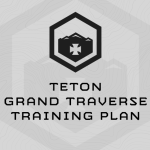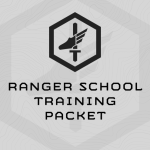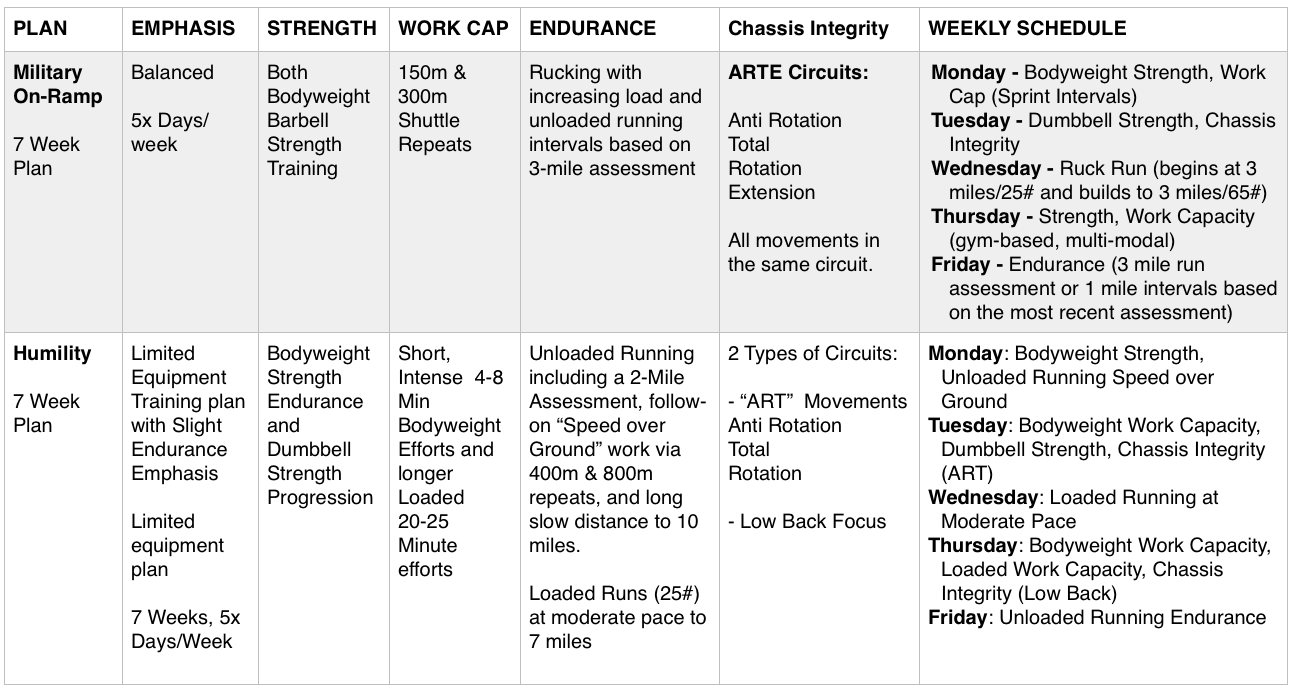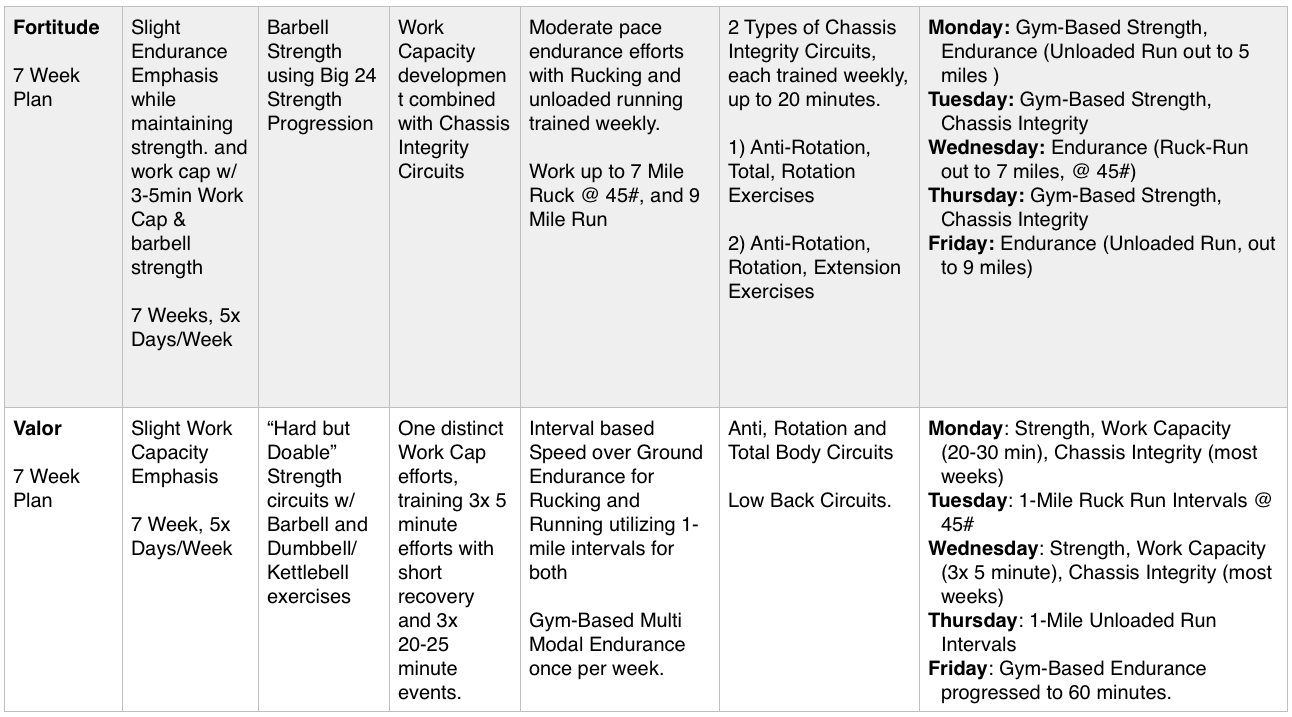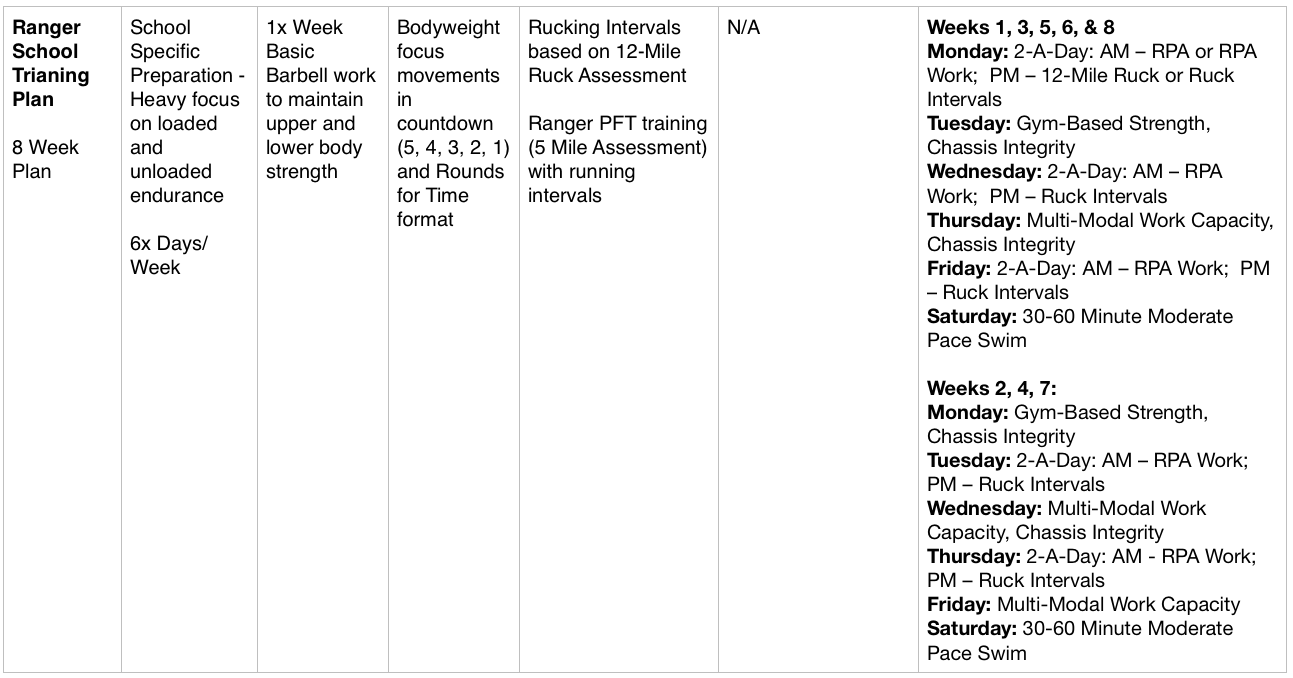KUDOS ON HUMILITY
“Last time I emailed you I was preparing to ship for Army BCT. I just got back from training a week ago. I just wanted to let you know I was by far one of the most physically prepared individuals throughout basic and AIT because of your programs.”
QUESTION
I’m an SF student here at SWCS in Ft. Bragg. I’ve recently gotten injured, severe stress fractures in both shins as the doctors put it. I’m on a no run/ruck profile for at least two months, so I figured I’d use this time to regain some strength I’ve lost over the pipeline by completing big 24 agin. Aside from that is there anything else you’d recommend? Especially to be able to maintain/ even still improve my running ability with my injury? Thanks for your time.
ANSWER
Cycling/spinning is about your only option. Step ups might help, but my guess is spinning would be best to try and improve running. Understand you’ll mostly improve at spinning, but there should be some transfer to your running.
– Rob
QUESTION
I’m currently going through SQT in the SEAL pipeline. I’m looking to take my fitness to another level and heard of Mtn tac through a friend. I was looking at the Greek hero program but wanted to get your opinion on what’s best for my schedule.
ANSWER
We just published (last week) the
Pirates Series of training plans designed as day-to-day training for tactical athletes with water-based mission sets (USAF Special Tactics, SEALs, BORSTAR, etc.). These 4 plans deploy our Fluid Periodization methodology but also include pool work 1x/week – swimming, finning, etc.
These are what I’d recommend.
– Rob
QUESTION
Hey guys! I’m a kinda a fat overweight Sfc Medic getting ready to leave the ARMY and go into contracting with triple canopy or SOC. My knowledge and experience are what enable me to get these jobs. However, my spine is jacked from years of time under rucks, body armor and jumps.
I need to be fit, quick and Strong. The only real limitations I have is that back squats if I do them to heavy will hurt my back and I’m probably the most inflexible dude on earth.
Yes I have multiple bulging discs and hurniations however, I need to make money while the money is good. What can you recommend?
Cheers!
ANSWER
QUESTION
I just enlisted in the Army and got 18X. I have 13 Weeks ans I am trying to get into great shape. I am interested in your Ruck + SFAS program but it says that I needed to plan back 42 weeks. As I don’t have that much time what do you guys think I should do? I saw that there is an SF Qualification course as well, but it doesn’t seem as intensive.
Best,
ANSWER
Weeks Plan
Good luck!
– Rob
QUESTION
Hi Coach,
In your “Long and Easy” article about endurance training, you mentioned that MTI’s time standard for long, easy training is 4 hours. Why 4 hours? Does that mean our longest workout should slowly build up to 4 hours and no longer?
Thanks
ANSWER
One theory in the endurance world is that an athlete has developed “aerobic base” for a single mode when he/she can move for 4 hours in that mode at his/her easy pace based on heart rate – around 65-70% of Max.
Under our current methodology, we consider endurance training any mode 45-60+ minutes long. We go over 4 hours.
– Rob
QUESTION
ANSWER
Options:
1)
SF45 Alpha – designed for tactical athletes ages 45-55. Less impact, more endurance work.
2)
Greek Hero Series – start with Hector. Full on day-to-day programming designed for SOF and those who aspire to that level of fitness. Concurrently train strength, work capacity, endurance (running, rucking), chassis integrity and Tactical Speed and Agility
3)
Humility – bodyweight strength, dumbbell work capacity, loaded running in IBA
– Rob
QUESTION
Hi Rob!
I just purchased the Humility program and I am doing day session #2 Tomorrow.
I am looking for some clarity on the burpee ladder test.
Is it I must make the designated amount of burpees within that timeframe in order to pass that level?
So if I did 52 burpees in 4 minutes I would pass that level but it I could only do 85 burpees in 6 minutes I have not yet passed that level?
Burpees Total
Level Min per Min Burpees
1 0-1 10 10
2 1-2 12 22
3 2-3 14 36
4 3-4 16 52
5 4-5 18 70
6 5-6 20 90
7 6-7 22 112
8 7-8 24 136
ANSWER
Exactly.
Each minute you have 60 seconds to get the designated burpees for that level. So level one, sprint through 10 burpees, and rest the remainder of the 60 seconds.
Level 2, sprint through 12 burpees, rest the remainder of the 60 seconds.
You can see how terrible this will become. Haha.
– Rob
QUESTION
What would be a good plan for a sedentary female who has no real history of excercise?
ANSWER
None of our stuff is appropriate for someone who is seriously deconditioned.
– Rob
QUESTION
Hey rob I’ve been a Starting Strength Heavy lifter for sometime now but I’ve noticed turning 40 that my joints and back are constantly aching. I’m looking to begin a new direction for my training. Something helps keep decent Strength but also can maintain decent conditioning. I’m 40 5’8 and at 215 pounds. Thank you sir.
ANSWER
I’d recommend
SF45 Alpha. “SF45” is an acronym for “Strength and Conditioning 45” and this programming is intended for athletes 40-55 years old. It’s what I’m doing – I’m 3 weeks from 49.
– Rob
FOLLOW UP
ANSWER
Kinda ….. the focus of our programming is to help athletes perform outside the gym. SF45 is a “base” fitness program, on top of which you’ll build sport specific fitness prior to events/seasons. For example, I’ll be dropping out of the SF45 programming soon to start our Backcountry Big Game Training Plan in preparation for bowhunting which starts Aug 15 here.
In general, the idea is to do base fitness programming – SF45 or Mountain Base – in the “space” between sport-specific train ups. So from a macro perpsective, your gym-based training revolved around your outdoor pursuits/seasons, etc.
What outdoor sports do you do? Any mountain sport trips planned?
– Rob
FOLLOW UP
QUESTION
I do have a Goruck event in September that I will be getting ready for closer to it. And January next year a deployment to Afghan. Other than that I do basic fishing camping and hiking with family. Big game is a goal for fall 2018. I still I still have a lot to learn in big game.
ANSWER
In between complete SF45 cycles or mountain base daily sessions/Greek Heroine Plans.
– Rob
QUESTION
Hey thanks for the info from earlier. I’ve lost access to my fully equipped gym but I do have access to Kettlebells all ranges and sandbags 40,60,80. Body weight and pull up bar is good to go. Can I still do the Operator Hector series and SF45 or do I need to consider something else?
ANSWER
You’ll need a fully equipped gym for both Hector and SF45. Look at
Sandbag Ethos or
Humility. We also have three Dumbbell/Kettlebell only plans, Larry, Curly and Moe – more
HERE..
QUESTION
I am looking into purchasing one of your workout plans. I’m in fairly decent shape about 5’11” 185lbs and 21 yrs old. I currently strength train 4 days a week and ruck about 3 mornings through the week. I also like to mix in a couple runs. I have time to do a morning and evening workout. Which program would you recommend for me to use? I am hoping to improve upon my total body strength while also continuing to improve my rucking/running performance. I’m all for something more intense that will keep me challenged. I have been looking at your Fortitude program, but I’m not sure if that is the best one you have for my situation. Please let me know.
Thanks,
ANSWER
Yes – start with
Fortitude. It’s an awesome plan which has you lifting heavy in the gym, as well as running and rucking.
– Rob
QUESTION
I found your site via a general google search, I think it has everything I’m looking for. But wondering if you could confirm? Below is a quick snapshot of who I am and what I’m looking for:
Who I am:
- 39-year old male
- Father of three young kids (7,5,2)
- Work out 5-6 days a week, but it can be difficult keeping a regimented workout schedule w/ kids and work
- Former military, still active with light upper body lifting, but lots of trail running, mtn biking, telemark skiing
What I am looking for:
- I would love to create a year-round strength/conditioning program tailored to the seasonal sports
- For example:
- Summer: I do 3 trail runs / week, each @ 8 – 12 miles with mtn biking in between
- Fall: I pare back mtn biking and running and want to get in shape for telemark skiing
- Winter: No running, just skiing on weekends (both lift-assisted and backcountry)
- Spring: pare back skiing, integrate running, prep for mtn biking
- I would love to increase certain weight training in each season to accommodate weekend runs/skiing and prep for next season
- Example: No squats in summer w/ all the running and biking, but lots of squats in fall to get ready for skiing?
- Example: no squats Thurs/Fri so I’m rested for weekend skiing?
I think your online site has everything I need for the above? Thanks for your help –
ANSWER
Our Mountain “Base” programming is designed as day-to-day programming for all-around mountain athletes either in-season or between seasons. Our
Greek Heroine plans represent our most recent evolution of this programming and concurrently train gym-based strength, work capacity, mountain endurance (running, uphill hiking under load), Chassis Integrity (our core training methodology).
But no programming can keep prepare you best for each mountain sport. So, directly
Directly prior to seasons, athletes need to drop into sport-specific cycles to prepare as sport-specifically as possible. You’ll see these on the site – our dryland ski, alpine climbing, Ultra Pre-Season and other plans.
Plans can be purchased individually or all accessed with Athlete’s Subscription.
– Rob
QUESTION
ANSWER
FOLLOW UP
QUESTION
Do you think the Peak Bagger Plan would be good if I wanted to climb Mt. Rainier? Thanks
FOLLOW UP
QUESTION
My fiance and I are doing a 14 day trek to Everest Base camp. I wanted to know if I should stick with the Big Mountain Training plan for that. I believe it is going to be mostly hiking slowly up the mountain, it will just be 7-8 hours on our feet per day. Thanks again.
ANSWER
QUESTION
I am currently a member and have purchased a few plans. I need advice on what plan to purchase to really improve my Army pft run time. I am currently coming in at 15 min and I want to make small gradual improvements. I noticed that there is a running improvement plan, and i want to know if that is the best fit for me. I would like to have some professional advice on the topic as i have tried everything from increasing mileage to running sprints and have not really made any significant progress. I would like to purchase a plan, but before i do i would like a recommendation.
thank you.
ANSWER
It includes specific training to improve the run.
– Rob
QUESTION ir,
Sir, I have the Ranger Program and I see that it is intended to be used 7 weeks before going to Ranger School. Will it still benefit me doing this, even though I am quite a long ways out from attending Ranger School? Thank you
ANSWER
There’s no hard in doing the
Ranger School Training Plan now, and then again the 7 weeks directly before you go to school. Doing it now will give you a great “snapshot” of your fitness.
Click
HERE for some of the feedback we’ve received on the plan.
– Rob
QUESTION
I’m seriously overweight, and not sure which program of yours to start with…
I’m 6’3″ and 42 years old. I was over 360 pounds, then lost down to 258, and after a couple of years, gained back up to over 300.
All of that said… Do you have a specific program that works for guys over 40, who have some lingering old injuries?
I’m noticing that recovery is harder than it used to be. I have only had two real injuries, back from when I was in the service. They both healed a long time ago, but at my current weight they are an issue. I dislocated my right ankle(i didn’t know that was a thing), and in a separate event, dislocated my left shoulder in a mountain bike accident. I am fully functional, but since hurting my shoulder, my pullups just sort of stopped. I never redeveloped the skill, but I used to do sets of one arm pullups back in the day when i weighed 200 pounds. My right ankle doesn’t feel stable when doing shuffling movements at my current weight. When I was around 200 pounds, it felt completely normal, though. The lightest weight I’ve been as an adult was 176 pounds, but I was running 10k 6-7 days per week at that point.
Hope to hear back.
Thanks,
ANSWER
We don’t currently have a specific training plan for seriously de-conditioned athletes.
This plan was built specifically to train guys for the Army’s PFT (2 mile run, 2 min push ups, 2 min sit ups). Why I like it for you to start is because we designed the plan so out of the gate you take the assessment and then use your assessment results for the follow-on progressions.
This way the plan automatically “scales” to the incoming fitness of the athlete. You may have to walk have the run, just get a handful of push ups and sit ups, but it doesn’t matter. The plan will “scale” to your initial results. Plus you re-asses 2x during the plan … so it continues to “tune” to your improving fitness and push you.
Also. Fix your diet.
HERE are our day-to-day nutritional guidelines.
Finally. I’m 49 and men our age die all the time. Don’t be one of them. Everything starts with your health.
– Rob
QUESTION
BLUF: Is it feasible to add your hypertrophy for skinny guys program to Crossfit/PFT work?
I am a skinny (5’11/145) military athlete with a heavy base in endurance and swimming. I currently maintain my fitness with Crossfit and leading the unfit members of my unit in basic USAF PT work. I am looking to build muscle mass as my size is becoming a limiting factor. Is it feasible to add your Skinny guy program to a 5 day/week out schedule? Or is another program needed?
More info, I work in a Non-Tactical unit, Lowest I have scored on a AF PFT is 97 and I typically exercise 5-days a week, comfortable with 2 a days.
Thank you for all that you do.
ANSWER
– Rob
QUESTION
Good evening,
I am currently deployed in Afghanistan and was looking into following your TACP training program as I aspire to cross train. However I do not have access to a pool, any suggestions to replace those swims with?
Thank you.
ANSWER
Any cardio work will work. If you have a rower, row 5000m. Moderate pace.
– Rob
QUESTION
Did a quick search on the site and couldn’t find info on this, sorry if I missed it. I’ve purchased a few of the mountain athlete programs, and did a great job following the programming during mud/off seasons, but now that it’s summer I’m having some difficulty.
I’m starting in on the peak bagger program, and I work out in the mornings. I’ve noticed that it makes me too sore/tired to get outside for after-work mountain bike rides, hikes, etc. And weekend backpacking trips and hikes need to be cut way down to make sure I have enough down time to recover. So here’s my question: How are the athletes you train able to follow your programming while still getting out a few times per week to play, and enjoy the benefits of the training, without becoming overtrained/too tired to give it all in training? Is it just a matter of “suck it up and do it, wuss”, or do you recommend cutting down on the fun outings while following a training program?
For a specific example, I live in Gunnison/Crested Butte, CO area. Mountain biking is a way of life in the summer, and I try to get out on the trails a few times per week. Is there any way to do that while still using the peak bagger program to train for an August 14er trip where we’re going to bag several 14ers over the course of a long weekend?
Thanks in advance,
ANSWER
Our programming should make you perform better on the mountain, not negatively impact your performance because of soreness/fatigue.
Here I stopped training my mountain lab rats on Fridays because of this …. they wanted to be fresh for weekend adventure.
You specifically, you can strategically think about what mountain biking is doing for you when it comes to peak bagging, and what it isn’t. What it is doing for you is helping your uphill climbing ability. We’ve seen this anecdotally – biking has good transfer to hiking uphill – esp. unloaded or with a light pack like you’ll carry for a peak-bagging trip.
What it isn’t doing is building eccentric strength for the downhill. This is what the Leg Blasters do in the
Peak Bagger Plan. Mountain Biking also isn’t training mid-section strength – which is what the sandbag getups in the plan hammer.
So, skip the step ups in the plan if your cycling lots, and try to work in the leg blaster and sandbag getup progression 2x, mid-week to keep you fresh for the hard weekend pushes.
– Rob
QUESTION
Hey there Rob! Hope all is well!
I had a quick question: I come from more of a powerlifting/ bodybuilder background in the last 10 years of training… I have thrown conditioning in the mix as well in the form of sprints, prowler work, some mid distance runs, etc.
Lately I have taken a liking to Spartan races. I have been doing fairly well actually, placing in the top 15 out of males in my age bracket. I just finished my first trifecta within 7 weeks– one of which was a half marathon in length through Montana (I’m from Wisconsin) the farthest I’ve ever run prior to this was a 5k and I managed to finish in the top 25% of participants and my last two races I have finished in the top 1&2% of participants in the open category.
I want to try to improve and see how far I can push myself, possibly start racing in the competitive waves, but with the caveat of not wanting to give up the size and strength I have. I’m not big by any means but the muscle and strength I do have has taken a long time to build and I don’t want to throw it away…I actually find my strength helps me immensely at obstacles where I see more of the endurance guys struggling. I still want to make strength, power, and hypertrophy part of my overall focus with an endurance component added in there with a higher level of work capacity. Basically an ultimate hybrid athlete.
Currently I have an almost 2.5x body weight Deadlift, 1.5x bw bench press and am just shy of a 2x bodyweight back squat— I’m sitting roughly at 170#. Any plans you would recommend right away for someone after my goals? Any guidance would be greatly appreciated.
Appreciate all you do man!
ANSWER
This plan comes from our Tactical side and concurrently trains gym-based strength, work capacity, chassis integrity (our mid-section programming methodology) and speed-over ground endurance – for ruck running and running. For you I’d make one addition to the plan, a long easy to moderate run on the weekend – 8 miles weeks 1 &2, 10 miles weeks 3&4, 12 miles weeks 5-7.
– Rob
QUESTION
Finished hypertrophy for skinny guys recently it was great!
I’m a Park Ranger/LE so I can go from road patrol to backcountry patrol, SAR’s, wildfires it all changes day to day… want to increase my strength and endurance without losing the mass I just put on (putting on a little more mass wouldn’t be so bad either) I was thinking Humility or Greek Hero pack. Advice?
Thanks
ANSWER
With your rural mission set, you’d be considered a “green” tactical athlete under the MTI classification – same as military SOF – Green Berets, and Wildland Fire/Rescue.
– Rob
QUESTION
Sir/Ma’am,
I will be racing next summer in a multi day, self sustained race across the Gobi Desert. I’ve ran ultra marathons and I ruck frequently since I’m in the military. I’m stuck deciding between your Denali training plan and the peak bagger plan.
The race is broken down roughly into four days of ~26mi, one day ~50mi, then final day is ~10mi. The pack I’ll be carrying will contain ~20-25# of supplies, over terrain ranging from dunes, to hilly plains, and some steeper spots.
Equipment wise, I have access to barbells, kettlebells, free weights, stair climbers, everything but a tire to drag, although I’m going to order a sled.
Can you recommend either of those plans or another one? Thanks.
ANSWER
I’d recommend the
50-Mile Ultra Training Plan. The bulk of your training should be trail running. Do the running in the plan with your pack – 25#.
– Rob
QUESTION
I am a National Guardsman an I’m looking to start one of your programs but I can’t decide which one. My top goal coming home is gaining strength. I’ve always been more endurance centric and on top of doing only high rep calisthenics/running for the past 6 months, I feel very weak right now. However I would like to maintain my conditioning and running ability. My day job is a career firefighter at a rather busy Fire Department. So I need both strength and conditioning but again I really need to get my strength up. What plan would you recommend for me?
Thank you,
ANSWER
I’d recommend you start with a focused strength cycle, then transition into our day-to-day programming for Urban Fire/Rescue.
– Rob
Subscribe to MTI's Newsletter - BETA





